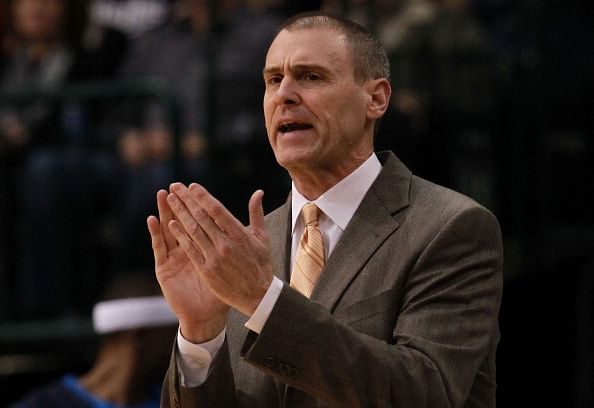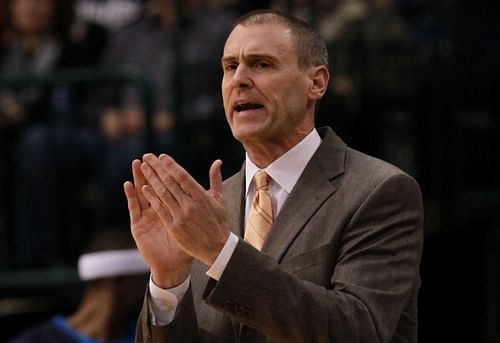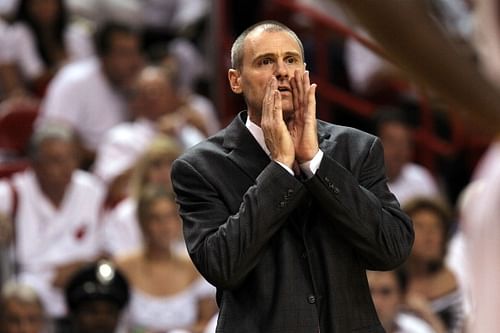
NBA Top 5 Coaches: No.4 - Rick Carlisle

Larry Bird seems to think Rick Carlisle is a coach any team would be lucky to have. And when Larry Bird speaks, you make sure you listen. Guess what, the Dallas Mavericks sure do agree that they are lucky to have him. One of only eleven people to win the NBA championship both as a player and as a coach, Carlisle has for long been one of the game’s most diligent students. Heavily under-rated, he is truly a well rounded coach, as his teams have always been known to play a combination of efficient, decisive offense coupled with an organized, disciplined defense. His obsession with attention to detail is very well known, as during his early coaching days, he used to have one playbook fully dedicated to half-court offensive systems. The only coach of the Mavericks to successfully be able to put a leash on Mark Cuban, he has a knack of going about his business quietly and effectively.
He spends his time during games walking up and down the court, looking on at proceedings with an almost Buddha-like straight face. Never one to give much away, his demeanor during games is remarkable. His calm exterior sometimes gives way to an outburst of emotion, during the course of which he turns into a crazy, gesticulating blur of a human. The tactician that he is, even his outbursts are well planned, just like his timeouts and substitutions. Always ready to take one for the team, his belief that his ejection will spur the team on to perform better has more often than not proven to be the truth. This is how he gets when he decides to have a meltdown, with emphasis on the word “decides”. Dallas were playing the Celtics last season, when Carlisle felt Nowitzki was being manhandled too often for his liking without any protection from the officials. Watch.
Guess what, Dallas won the game.
Carlisle started off his coaching career as an assistant, first for the Nets under the legendary Chuck Daly, and then for the Trail Blazers. His big break came when he started working for the Indiana Pacers as an offensive coordinator, under his Celtics teammate Larry Bird. The next two seasons were the best ever in the franchise’s history, with the Pacers going to the East finals in one and the NBA finals in the other. Following the 2000 season, Carlisle took over as the head coach of the Detroit Pistons, leading them to two very successful seasons for a team that was rebuilding. He was awarded the Coach of the Year for the 2002-03 season, as the Pistons finished runners-up in the East. However, he was dismissed at the end of the 2003 season, fueled by his lack of trust in the young players, and his interest in moving back to Indiana to take over the head coach position there.
His reign in Indiana coincided with a tumultuous period in the Pacers’ history, as there were periods of great successes, like the 03-04 season when the Pacers lost to Carlisle’s old nemesis Detroit in the Conference Finals, and the 04-05 season, when he took them to the playoffs despite missing some of the roster’s best players through suspensions enforced as a result of the now infamous brawl between the Pacers and the Pistons. His last season in Indiana saw them failing to make the playoffs, as a result of which Carlisle was fired. His reigns at both Detroit and Indiana saw them going through an offensive slump, as the tiring half-court sets that he used to play were not working, and his emphasis on defense sort of slowed down their offensive tempo.
As a talented young coach, the fact that Carlisle was fired from his first two jobs indicated that there was some level of growing up to do for the coach too. His teams were a combination of talented, temperamental youth (Artest, Jackson and O’Neal) and experienced professionals eager to achieve something big in their careers. However, what was obvious was that although he could bring his teams together for a season or two, he could not help them achieve continued success over a period of time. His unwillingness to throw the young players in at the deep end, and the refusal to budge from his favored conservative offense drew him flak, and caused his stock to fall. The inability of his teams to exhibit toughness during the playoffs, and achieve all they can, reflected poorly on his qualities as a coach. So once the Mavs came calling in 2008, it was seen as a match made in heaven, and was billed as the meeting of two perennial playoff underachievers. The rest, as they say, was history.

Carlisle has had a very successful reign with Dallas so far, taking them to the NBA championship in 2011. He has evolved into a coach who listens to his players, engages them in fruitful discussions, and comes out with conducive solutions. With the Mavs, he has relaxed his rigid, half court offense into what he calls the “flow offense”, which focuses on spacing the floor out well, and calls for a lot of patience in the passing. The continuous ball movement, allows the team to wait for the best option during any offensive set, and so, increases the efficiency manifold. The opportunity to work with a veteran team was something Carlisle was waiting for, as the team would be willing to be coached, and would have the necessary experience and know-how to deal with a variety of different situations. Also, Dallas offered him something no previous employer of his could – the chance to work with an all-star of the calibre of Dirk Nowitzki. Also, coaching Dallas would be a totally different proposition compared to his earlier jobs. Everywhere else he’d been, he had to take a team full of raw, unproven talent working hard to get into the business end of the season. With the Mavs, he was taking over a franchise which is one of the most stable in the NBA, in terms of its continuous playoff appearances. What was needed was for them to show that they could do it in the playoffs too, and shed that ill-wanted tag of chokers that had been bestowed upon them. And this period of his career has shown his evolution into a coach who plays to his team’s strength, and not the other way round.
The championship winning team that Dallas had was full of true shooters out on the wing, and defensive specialists not so good on the offensive end. So to suit his team, Carlisle used to draw up plays which would maximize their offensive output. Again, all his plays are basically drawn up with a psychological boost in mind. Crucial to Dallas’ run were their defensive specialists, Chandler and Stevenson. However, they were also the weakest offensively. In order to keep them keyed in defensively, they used to have plays directed specifically at them, generally at the beginning of quarters. For example, Chandler’s main role in the offense was to set screens for the guards (Kidd, Terry, Barea) at the high post. Coming off the screen, Kidd would make the simple pass to the guy with the best available shot, and Barea would dribble penetrate before either kicking it out or passing it to a shooter. Works like clockwork, job well done. However, there was also a variation, wherein Chandler would roll off of the defender after setting the pick, and move to the rim, where a lob would be thrown up for him to unleash his fury. The following videos are a case in point:
Stevenson would pull off to one of the corners, and a good spate of ball rotation would see him finding the ball in his hands, or during a transition opportunity, instead of driving to the rim, Dallas would always look to the wing to spot up their shooters.
Most of the attacking sets would see Dirk setting the pick, and rotating, so either he or the ball handling guard (mostly Terry) would get a good look at the basket. What maximized the efficiency of this play was the availability of shooters spaced around the floor, so once, the pick and roll gets going, there are multiple options for the guy with the ball: One, he could shoot the ball, or two, he could pass it to the guy who he executed the pick and roll with, or three, he could drive with the ball, invite extra attention and then pass the ball to an open shooter or take it to the hoop. Dirk and Terry were on of the best pick and pop duo in the league, and the floor spacing of the Mavericks was always such that they get Dirk and Terry to their favorite spots on the floor, so that they could then execute the play perfectly. This video (albeit from the 2012 season) showcases the Mavs one-two punch the best:
Also, some isolation plays run by Carlisle included Kidd posting up the smaller guard on the opposing team, which would result in an easy lay-in, or Kidd feeding Beaubois with an alley-oop. The play run with Beaubois was normally a misdirection play, using Beaubois’ height to his advantage. Him being of not so tall a stature by NBA standards, nobody would expect him to be going up for lobs. However, how this play was designed was that Beaubois passes the ball to Kidd, and then darts off in the opposite direction, straight to the rim, waiting for the lob to come his way. His run to the basket would be unimpeded on account of a screen set by the forward (Dirk usually). These plays would generally be run early in the 1st or 3rd quarters (they have been run all through Beaubois’ career with the Mavs, not just the 2011 season), while the defense is still not set and does not anticipate the play. Another play designed at increasing the confidence of the guy. Beaubois is a streaky shooter, and scores in spurts, and getting him an easy basket could always open the floodgates for him any given game.
One of the reasons Dallas has been very good offensively is its late game execution. Central to their late game play is that the ball will find its way into Nowitzki’s hands, from where he takes the decision as to what to do with the ball. What does happen before the ball comes to him are a spate of staggered screens, which are run to facilitate easier shots for Nowitzki and Terry, or to attract help defense if they drive to the basket, resulting in a perimeter shooter open with a good look (if the pass happens). The screens are generally set by the Centre, moving swiftly between defenders to help space out the floor. Observe that the plays are set to the strength of each player specifically. Nowitzki likes going to the left side more often than not, so most of his plays are focused that way, while Terry likes to move to the right off the dribble, and so most of his moves are in that direction.
The principal reason for Dallas winning the championship was their defense, and defense is something the Mavericks aren’t very well known for. Carlisle on the other hand, is a strong defensive coach, who expects a lot from his players on the defensive end. The teams he coached earlier were both very athletic and defense oriented, and so it was not that difficult getting that effort from his players night in night out defensively. Dallas however were a different cup of tea. With the franchise consistently one of the more flashier teams going forward, the change in mindset achieved almost overnight in working hard and putting in a shift defensively was remarkable. The defensive schemes were structured to suit the roster’s strengths on the defensive side, with a constant switch between a 2-3 zone and man to man confusing opponents and forcing them to take low percentage shots. The presence of versatile defenders like Shawn Marion and Jason Kidd helped in creating matchup issues, with Marion sometimes guarding the point guard of the opposing team, while Kidd would guard the principal scorer. Also, using a mobile center while operating the zone helps keep the rest of the defense on its toes, ready to provide weak side help if anybody tries driving to the rim.
Most of Carlisle’s defensive systems revolve around good spacing, and active hands while facing the ball, thus forcing the opposition to take tough shots. An interesting statistic is that his teams have been in the top 12 in points allowed in all seasons but one. Maybe, just maybe he is one of the best coaches around on both ends of the floor.
Getting into the Carlisle rotation is in itself a tough job. Players might be thinking they are performing well, when one fine day they will find themselves out of the rotation, and get a chance only after a couple of games. What his ploy is to see how you respond to the DNP-coach’s decision, and whether it sparks your play the next time you get your chance. Like throwing Barea into the starting lineup against the Heat in Game 4 of the Finals. Or the recent example of Jae Crowder, the rookie who was kept out for a couple of games, before being thrown in against the Knicks, where he played his best game so far hands down.
The courage he exhibits in his substitutions is exemplary, the most common instance of that is the innumerable times Dallas finish games with a 3-guard line up, forcing teams to make adjustments late in the game, which gives the Mavericks enough time to make a couple of decisive plays and get that little bit of breathing room needed to clinch the game. It’s no coincidence that Dallas had one of the best 4th quarter records in the league, alongwith one of the best records in games decided by less than 5 points. His ability to break opponents’ momentum by taking timeouts very quickly is uncanny.
It is not easy to work with as hands on and as demanding an owner as Cuban, but as Carlisle has proven, it is something quite possible. Probably his dry sense of humor has kept him going.
“We’re doing it every way you can do it,” Carlisle said before this season’s game against the New Orleans Hornets. “If we were a sex manual, it’d be a best-seller.”
Maybe he does share a lot in common with his doppelganger, Jim Carrey.
Whether he can work his magic with this year’s Dallas roster, one doesn’t know yet. What we can be sure of is that Carlisle will make sure his team comes out to play every night, and will push them all the time to become the best that they can, just like he strives to do.
Here’s to Rick Carlisle, probably one of the league’s most versatile coaches ever.
Read more on the Top 5 Coaches in NBA here.